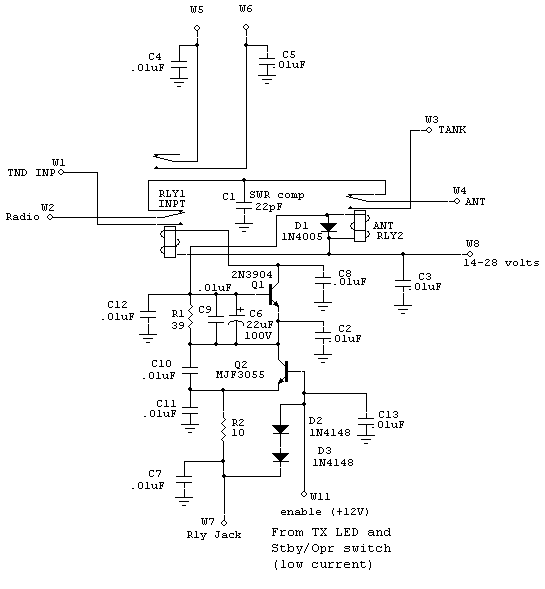
This is the Ameritron T-R relay module that replaces open frame relays in the AL12 series of amplifiers. RLY1 is a DPDT 8 amp, and RLY2 is either a DPDT 8 amp with contacts in parallel, or a SPDT 16 ampere contact relay. This circuit requires identical relay coil currents. Do not mismatch the relay coil currents! Do not substitute other relays with verifying timing.
This circuit accelerates RLY2 closure. This will cause RL2 to be audibly louder than normal upon closure, because RLY2 is accelerated. This does not appear to have an observable effect on relay life.
Important Note:
W8 voltage and R1 resistance is determined by relay characteristics. W8 voltage does not match the relay voltage! Sequencing must be verified at the operating voltage, if any substitutions are made. R2 determines relay coil hold voltages by setting relay hold current.

Q1 is a switch. Q1 holds the input relay off until C6 charges.
Q2 is a current limiter. Q2 holds maximum current to the total relay coil current for both relays. This does things. It doubles the current into RL2 when activating, because at that time RLY1 is held off, and it prevents relay damage from excessive current. Q2, while only handling 70 mA at ~12 volts maximum, is physically oversized, because it dissipates almost as much power (0.84 watts) as the relay coils.
Operation:
The supply at W8 has to be much higher than relay coil voltage. W7 (relay amplifier control jack connection) is limited in open circuit and transient voltage to the voltage applied at W11. W11 should not be more than 12 volts nominal.
In the off state, C6 is at zero volts. Q1 is held off. When the emitter of Q2 is grounded, the base is 1.4 volts above W7. Transistor Q2 becomes a constant current source, approximately equal to .7/R2 = 70 mA
This allows 70 mA to flow through Q2. Since RLY2 has a high starting impedance, and since RLY1 is held off by Q1, RLY2 sees almost full W8 voltage on start. It also has the full 70 mA (double current) available. This closes RLY2 very fast.
As C6 charges, Q1 allows RLY1 to share current. RLY1 pulls in with a slight delay. This delays the input and operating bias (W5 and W6) until after the output has connected solidly to the load.
In the steady state, relay voltage drops to a safe holding voltage and current.
Upon release of W7, RLY1 immediately drops. RLY2 is delayed by back EMF current through D1.
It is advisable to never substitute relays, since this circuit is sensitive to relay coil current and voltage.
Note:
These relays are 10-16 ampere rated hot-switching current relays. They are some of the highest-rated current gold-flash contact relays with fast response time available. The output relay has been tested to hold up to 14 amperes of RF current, in a steady state hold, at 30 MHz. This current is actually higher than current of old open frame relays, which were limited by flexible wire lead and contact spring carrier heating at 30 MHz. They are a vast improvement in relay life and receive connection reliability. Like any flash plated softer contact, they are easily damaged by hot switching. Be sure the exciter does not transmit RF sooner than 3 mS after sending a relay closure signal to the amplifier, or transmit RF more than 0 mS after signaling for an open.